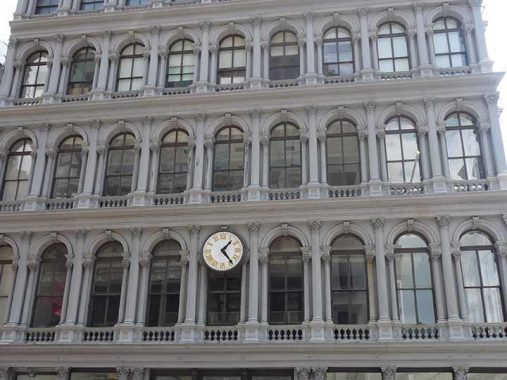
HERE’S 488 Broadway at Broome Street, the Haughwout (pronounced HA-wout) Building. Some architectural experts call it the most beautiful castiron building in NYC. It has competition there especially in Soho, but this is certainly one of the more massive ones. It is among the oldest: it goes back to 1856, when the castiron movement begun by James Bogardus was just taking hold. The architect was John B. Gaynor and the original owner, Eder V. Haughwout (there aren’t any names like that nowadays, either). He was an importer of table and glassware who supplied china to the White House and exhibited at the ill-fated Crystal Palace at what would be Bryant Park in 1853. This was his showroom and retail store until 1869; thereafter it was home to a succession of wholesalers. These days, the ground floor houses a toy store, MINISO.

The exterior presents a stately succession of arched windows on the top 4 floors, each consisting of 2 Corinthian columns with another Corinthian in between.
This basic window unit is repeated 92 times on the two façades, one facing Broadway and he other facing Broome Street (above). There are 4 tiers of each of these arches, one above the other, each supporting a full entablature that runs around the two sides, giving a strong horizontal line at every floor. Cast-Iron Architecture in New York, Margot Gayle and Edmund V. Gillon Jr.
I haven’t been inside the building but among its other attributes is the presence of the very first Otis elevator. Architect Gaynor also placed the first elevators west of the Mississippi in San Francisco’s Palace Hotel.
Footage of an elevator in an adjacent building that is nearly as old:
https://www.youtube.com/watch?v=9LgOCLXdG9I
The big clock on the Broadway side is unusual for a Roman-numeral clock. Why? The “four” is rendered as usual… IV, instead of the IIII usually on clocks of this type.
The Haughwout Building was, in the early 1960s, in the gunsights of traffic czar Robert Moses, who wished to build the Lower Manhattan Expressway along Broome Street to connect the Williamsburg and Manhattan Bridges and Holland Tunnel. An elevated expressway would have been erected over Broome and all the buildings on its north side would have been torn down to accommodate the expressway’s width. For a variety of reasons that included the staunch opposition of coalition of activists and neighborhood residents, however, the massive project was stalled and finally demapped in 1969 even though some of the approaches near the Manhattan Bridge, and an underground approach at Broome and Chrystie Streets, had already been started. Soho, then a depopulated, nearly deserted area, would subsequently flourish, though mostly for the higher-incomed.
As always, “comment…as you see fit.” I earn a small payment when you click on any ad on the site.
5/19/23


6 comments
I heard that those cast iron jobs are supposed to be fire proof.I
never heard of one burning down.
Beautiful building. Glad for the opposition to the Power Broker.
>> (pronounced HA-wout) << Does the second syllable rhyme with lout or loot ? I can't figure out what language it comes from!
Answering another comment: My father, many years with NYFD, once commented to me that "fireproof" is a misleading term, that steel, concrete, stone all give way to the heat of a fire. The idea, he said, was to be fire-resistant, to contain the fire long enough for firefighters to get there and save the building and those in it. A cast iron exterior is certainly better than wood at not immediately catching fire from a nearby building on fire. But the interior of those buildings was too often wood beams and floors and iron columns, which he considered pretty terrible. I got the impression he knew this from experience.
I’m sure the name got Anglicized by many descendants to “Haywood” or something like that, but in the original Dutch, it would be pronounced something like “How[ch]-woat,” the “ch” being like “Chanukah” or “Loch Lomond”. It most certainly isn’t “Hogwarts,” which it looked like to me… 😉
Yes,now that I really think about it,I recall that fireman used to call Soho
“Hell’s Hundred Acres” because some building always seemed to be going
up in flames there.Probably by arsonists pulling insurance jobs.
Beautiful building